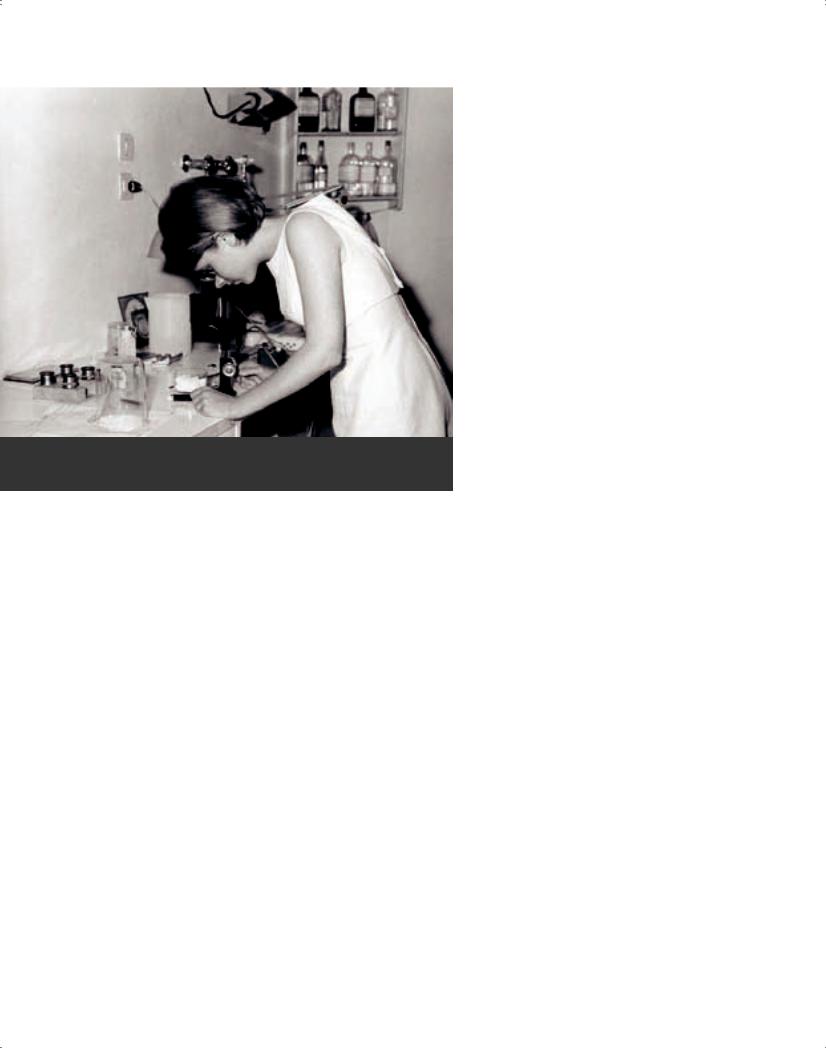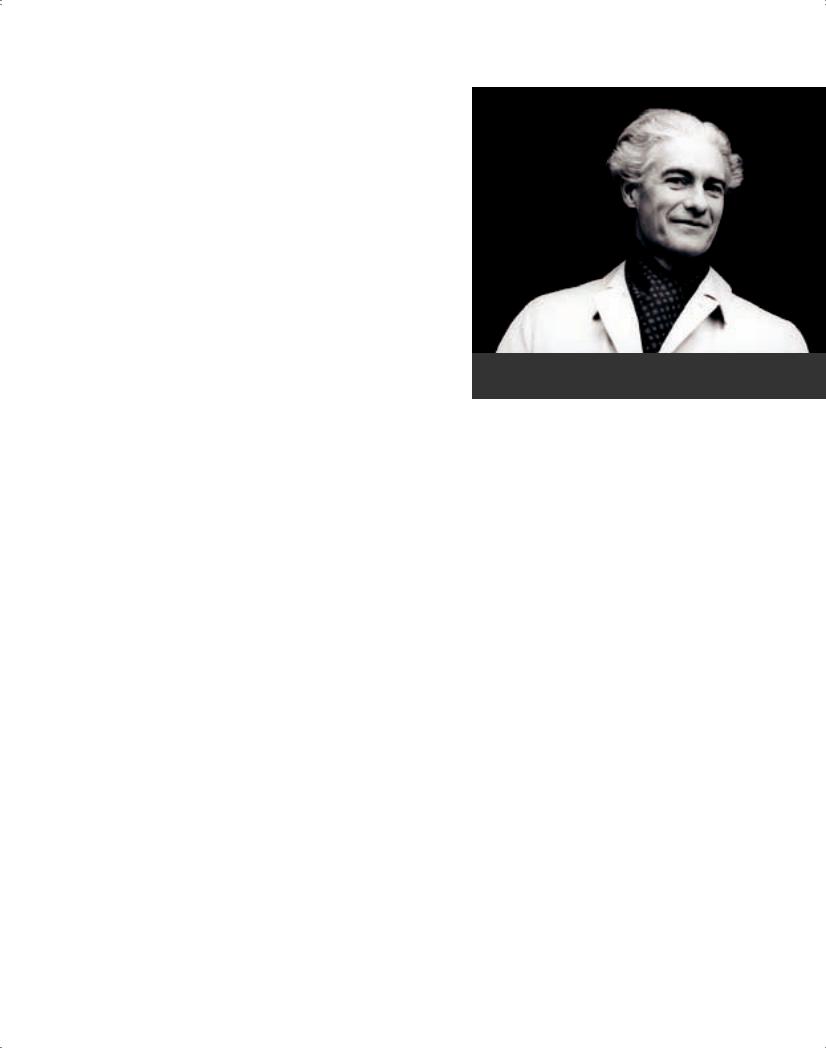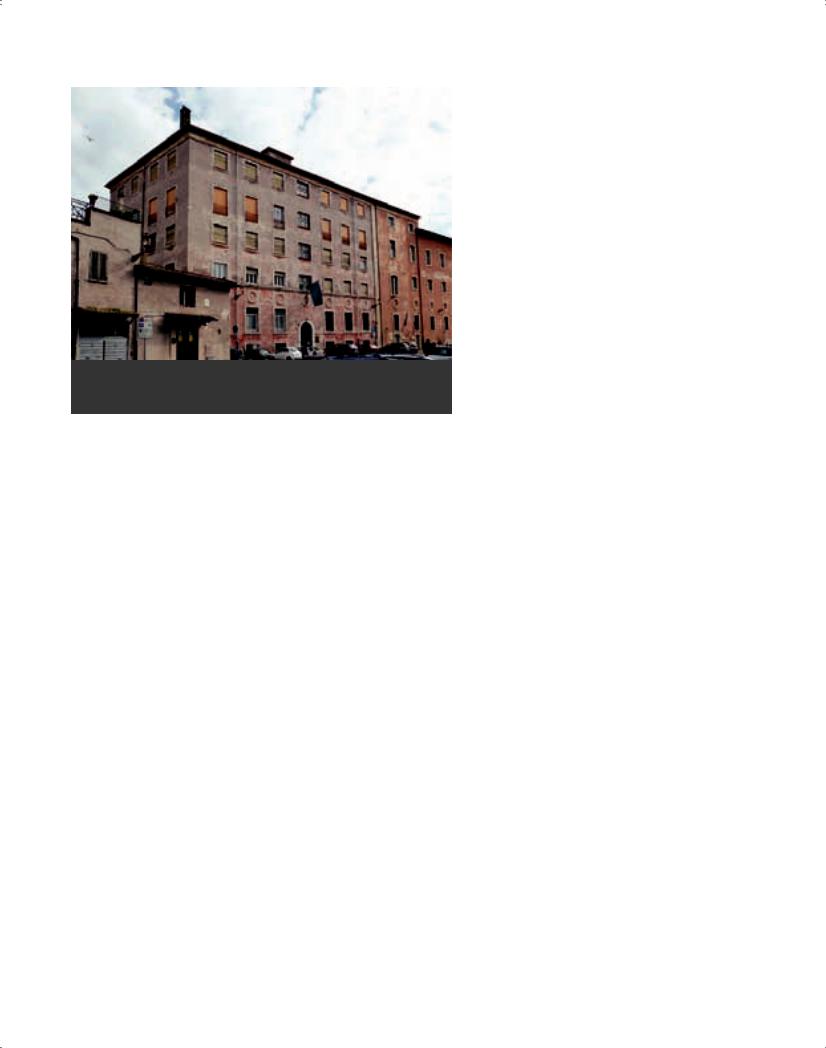
ICCROM_ICS11_History_en
.pdf
Figure 3 23
ICCROM’s didactic laboratory at via Cavour 221, in the 1960s
medieval casket (the Anagni Casket) as a pilot project for possibly establishing a small training unit in Rome.107 Torraca recalled the humble beginnings of the Rome Centre108:
“In |
the via |
Cavour flat that was our office |
in |
Rome, |
Plenderleith had actually created |
a laboratory, a 3m2 toilet turned into a photographic darkroom where he developed and printed his black and white photos. The equipment included a crowbar, because the special lock that had been fitted to protect the equipment had once locked him in. At the time it was supposed that all the scientific support for the Rome Centre would be provided by the Istituto Centrale del Restauro, just next door - an arrangement that worked well enough within the (then) limited scientific capability of the Istituto, as the relationship between the neighbours was always easy and friendly.”
Laura Sbordoni-Mora has also recalled when she and her husband Paolo started working with Torraca:
“Torraca is the first and only chemist with whom we worked willingly. Giorgio is a friend and has always stayed a friend. He is very youthful;
he rides the bike, plays tennis and travels with girls. … He was a university professor and taught at San Pietro in Vincoli at the Faculty of Engineering. As he knew Brandi he had some interest in visiting the Institute nearby. He would come every day. He used to say: ‘I found myself at the Institute, and found a door through which I entered because I saw some important work. And there I met Paolo and Laura Mora’. He used to come every day. The dialogue Paolo and I used to have with him we never had with any other scientist. Because he used to ask us: why is this so? And Paolo would answer: yes Giorgio, but… at this point what’s the best thing to use? It was a dialogue on what a work of art was and what the best thing to use was.”109
Reflection on the period 1960-1970
It was UNESCO and ICOM that laid the foundations for the development of the International Centre for the Study of the Preservation and Restoration of Cultural Property, the Rome Centre, but the start of its activities and the basis for its future depended on the contribution of human beings. These included the experts who were selected for the Provisional Council, and subsequently those who continued to guide the organization in the elected Council. However, the real onus of realizing the Centre and of clarifying its vision and mission depended on its staff. Plenderleith as first Director acted as an ambassador to make it known and to raise enthusiasm for its mission. But he was also a leading scientist who could offer wise advice to professionals.
Philippot as Deputy Director in this first period was a humanist and art historian. He was responsible for the development of ICCROM’s policies and strategic programmes, based on a network of contacts with high-level thinkers and practitioners in the conservation field around the world. In this early period, the Centre could already establish institutional and professional links that were the basis for its future network. It also participated in an increasing number of international projects, including UNESCO’s campaigns in Egypt, Florence and Venice, and was a key protagonist in the 1964 Venice meeting that produced the Venice Charter.
The Centre contributed to a critical assessment of the existing humanistic and scientific experience in the field of conservation, providing the platform for the enhancement and integration of this knowledge into technical cooperation, research and training programmes for which it has become known throughout the world. A short account of the organization’s first ten years and the planned future developments was published in a small booklet:
40 |
ICCROM and the Conservation of Cultural Heritage. A history of the Organization’s first 50 years, 1959-2009 |
|
|

The First Decade: 1959-1969.110 The opening chapter by Hiroshi Daifuku: ‘The Rome Centre - Ten Years After’ is included here as Annex 4.
More than a decade later, Plenderleith as Director Emeritus was invited to write an editorial for the ICCROM Newsletter 9, in which he described the principal issues that had marked his period as Director. He concluded:111
“One recalls, in retrospect and with gratitude, the great host of those who befriended and guided ICCROM in its early struggles and gave us the necessary encouragement along the way. We owe them everything. As a well-established organization we now have responsibilities and possibilities for service as yet uncharted.
I am reminded of a statement made by Lindbergh in the course of a speech in Paris, I think, which might be emblazoned on the portals of San Michele. It ran thus: “I don’t think that there is anything more important than conservation unless it be survival and these are so closely related that it is hard to consider one without the other.
Anyone visiting ICCROM at San Michele today must be impressed by the spirit of dedication that prevails among staff and participants alike. This is inspired by the knowledge that they are working together in an international crusade for the benefit of mankind. After years of wars, dissentions and destruction, the nations are coming to realize the universal and increasing value of what remains and are increasingly interested in having it preserved in accordance with the highest standards of modern technology.
Asked by a casual London acquaintance the other day, ‘By the way, Plenderleith, is that thing of yours in Rome getting on all right?’, I replied with the masterly understatement, ‘Yes!’”
3 The Rome Centre (1960-1970) |
41 |
|
|

4
International Centre for Conservation (1971-1977)
International context
The 1970s was a crucial period for the further development of international collaboration, consolidating the activities of a number of international organizations, especially UNESCO, ICCROM, ICOM, and ICOMOS and the Council of Europe. Notably, this period saw the further development of international doctrine. The General Conference of UNESCO adopted two important conventions: the 1970 Convention on Illicit Traffic and the 1972 World Heritage Convention. In the latter Convention ICCROM, ICOMOS and IUCN were recognized as its three Advisory Bodies. The adoption of this Convention came shortly after the United Nations Conference on the Human Environment in Stockholm held in June 1972, the first major conference on international environmental politics which gave birth to UNEP, the United Nations Environment Programme.
The real impact of the World Heritage Convention was felt in the 1990s when a large enough number of States had ratified it and when the processes of inscription and management of properties on the List had been tested. In 1972 UNESCO also adopted an international recommendation concerning the protection of cultural and natural heritage on the national level and in 1976 two further recommendations, one concerning the international exchange of cultural property, the other on the safeguarding and contemporary role of historic areas.112 This
latter recommendation was important for ICCROM which participated in its preparation. It introduced a more holistic approach to historic areas, taking into account the balance and specific nature of the parts, including human activities and the surroundings. The 1972 World Heritage Convention also established a link between cultural and natural heritage, of which the consequences started being felt more than two decades later. ICCROM was directly involved in these new conceptions. In fact, in many cases it had anticipated them by testing and developing methodologies in its international training programmes. These were now consolidated and gradually also ‘exported’ as a methodology to Member States.
The Council of Europe, CoE, continued to be active in the field of safeguarding cultural heritage, having adopted in 1969 the European Convention on the Protection of the Archaeological Heritage. Particularly important was the European Architectural Heritage Year in 1975 when CoE adopted the European Charter of the Architectural Heritage and the Amsterdam Declaration, a result of the Year’s concluding conference in October of that year. These documents introduced the concept of ‘integrated conservation’ of even modest built heritage as a capital of irreplaceable spiritual, cultural, social and economic value. They gave special attention to development of the legal and administrative framework, finances, techniques and the training of skills. Indeed, these charters anticipated the 1976 Recommendation by UNESCO already referred to.
42 |
ICCROM and the Conservation of Cultural Heritage. A history of the Organization’s first 50 years, 1959-2009 |
|
|

In the 1970s, ICOMOS organized several conferences which adopted recommendations. The third General Assembly, at Budapest in 1972, adopted the Resolutions of the Symposium on the introduction of contemporary architecture into ancient groups of buildings, and the fourth General Assembly, at Rothenburg in 1975, adopted the Resolutions of the International Symposium on the Conservation of Smaller Historic Towns. These resolutions contributed to broadening and specifying the definitions of the 1964 Venice Charter.
In the museum field, ICOM was an important generator of activities. The triennial General Conferences of ICOM debated up-to-date themes:
•In Paris and Grenoble in 1971: museum in the service of man, today and tomorrow - the museum’s educational and cultural role;
•In Copenhagen in 1974: museum and the modern world;
•In Moscow 1977: museums and cultural exchanges.
ICCROM continued to collaborate especially with the ICOM Conservation Committee for which it acted as Secretariat with Philippot taking on the role of Secretary-General.
As a result of all these developments in international doctrine, there was a major change in the definition of heritage and consequently in management processes. This was already reflected in terminology. Instead of ‘cultural property’, it became increasingly common to use the term ‘cultural heritage’, indicating that the issues concerned not only material culture but also associated human activities. The new thinking anticipated the notion of cultural landscape that was to be formally introduced by both UNESCO and Council of Europe in the 1990s.
International Centre for Conservation (1971-1977): the directorship of
Paul Philippot
Administration
Personnel
In April 1971 the General Assembly confirmed Paul Philippot as Director of the Centre. At the proposal of the new Director, the newly elected Council nominated Giorgio Torraca as Assistant Director of the Centre. Elizabeth Haswell Ambrosi (UK) was employed as bilingual typist (later becoming secretary to the Director) from 1 March 1970. As from 1
Figure 4 1
Paul Philippot, second Director of ICCROM (1971-1977)
January 1973, Jukka Jokilehto (Finland), previously an assistant to the Architectural Course in 1972, was engaged as architect responsible for the preparation and organization of the Course of Specialization in the Conservation of Historic Monuments and Sites, and Marie-Christine Uginet (France) was engaged as full-time documentation officer (having worked part-time during 1972). With the retirement of Amendola at the end of 1973, Uginet was nominated Librarian as from 1 January 1974. From 12 February 1976, the restorer Paul Schwartzbaum (USA) was employed as Coordinator of the Course on the Conservation of Mural Paintings.
In 1973 Giulio Catena, who had been responsible for the administration, resigned in his capacity as a civil servant but was re-engaged by the Centre on a provisional basis until, from 1 September 1975, Paolo Pegazzano (Italy) was employed as the new Administrator. This allowed a reorganization of the Centre’s administration, including a complete inventory of its assets, a comprehensive system of insurance, the establishment of an internal accounting system, rationalization of the procedure for purchasing equipment, and the installation of a telephone system with central switchboard. Following the decision of the Council, the firm Price Waterhouse was instructed to report on the Centre’s position with regard to relevant fiscal and social legislation and to audit the accounts (1975 onwards).
Architect Bernard M. Feilden was employed as consultant for the Architectural Conservation Course for the years 1975 to 1977. Paolo Mora continued in his capacity as long-term consultant to the Course on the Conservation of Mural Paintings and related
4 International Centre for Conservation (1971-1977) |
43 |
|
|

problems while Jacques-Louis Rollet-Andriane also continued as consultant for the Centre’s relations with the Italian Government.
Member States and the Council
In 1971 the Centre had 53 Member States, and by 1978 the number had grown to 63. The USA joined the Centre in 1971, Australia in 1975, and Canada in 1978. These adhesions led to an increased budget such that in 1978 the total contributions of Member States had risen to US $1 056 888. In May 1971, when Paul Philippot was elected Director of the Centre, the Chairman of the Council was Arthur van Schendel (The Netherlands), who had also been one of the first fellows of IIC from 1950.113 Philippot has recalled the character of some of the Council members:
“Arthur van Schendel was Director-General of Rijksmuseum in Amsterdam, and had been involved in the problems of ICCROM even before the creation of the Centre. In the context of ICOM, he had been interested in
Figure 4 2
ICCROM General Assembly in 1971. Soprintendente Riccardo Pacini, Paul Philippot, Steen Bjarnhof (Denmark) and Svetislav Vučenović (Yugoslavia)
conservation; he was a friend of Coremans, had lived a large part of his youth in Italy; he spoke Italian fluently, having lived in Toscana, he knew Brandi, a really international personality and with an important responsibility in the field of museums. He was the one who later established the conservation institutes in Holland on the model of Brussels. Van Schendel was an extremely useful person at the beginning of the Council, especially due to his capacity to mediate and his juridical spirit. Smoking his pipe, he solved all the problems with great calm, and without ever being agitated.
Johannes Taubert, an old friend of mine, directed the restoration atelier of Munich in Bavaria, Bayerische Landesamt für Denkmalpflege. When I went to meet him and Gertrude Tripp in Vienna or Munich, the two explained all their current problems. Listening to them, I could practically have a picture of the problems in Mittel Europa. It was extremely useful; they did not come just to obtain something, but to participate and to contribute by presenting their own problems. They knew that the perspective of ICCROM could provide them with another dimension thanks to a certain philosophy and a certain policy.
Vasile Dragut had a similar approach with that of Tripp and Taubert. He introduced his country to us, and organized seminars with our assistance, which was a very difficult task in Ceausescu’s Romania. He succeeded in doing so and was the only person who, during his long period in the ICCROM Council, made questions in the field of humanities. All the others made administrative questions.
Om Prakash Agrawal was another type of person; he was from the Museum of New Delhi working in the laboratory where he became the director. He had a great sense of organization. I would even say that Agrawal was an Indian Coremans. When I was nominated Director he made a proposal that I will never forget, which was to invite me to visit India and its neighbouring countries. He would have organized all and would have accompanied me. We thus travelled together day and night for six weeks. It was a magnificent trip for understanding the problems of the region. We were in various parts of India, in Ceylon, Malaysia, Indonesia, Thailand, and Nepal. It was an important trip to be able to see and to speak; he already had friends and acquaintances in the region. Therefore it was a perfect introduction to the problems and to the people of these countries.”114
44 |
ICCROM and the Conservation of Cultural Heritage. A history of the Organization’s first 50 years, 1959-2009 |
|
|

Figure 4 3
The location of ICCROM at via de San Michele 13 from 1972
The adhesion of the United States of America became a real watershed in the programme of the Centre. It was very much to the credit of Plenderleith with the help of IIC which was well represented by its members in the USA. The US authorities agreed to second the architect W. Brown Morton III to the Centre for three years. At the suggestion of architect Charles E. Peterson, the founding father of historic preservation in USA, Brown Morton, representing the Centre together with Gaël de Guichen (who had been engaged by the Centre as course and laboratory assistant from 1 August 1970) led a study tour in Europe for a group of young American architects. They visited recent and past restorations in various European countries, which led to many new contacts in the field of cultural heritage. On his return to the USA Morton had further influence there through being involved in the preparation of the first version of The Secretary of the Interior’s Standards for the Treatment of Historic Properties, published in 1978. This fundamental document for US preservation policies was ultimately based on the principles of the Venice Charter, though with some differences deriving from the cultural requirements of the country.115
Premises
In the 1960s the Italian Government had proposed that the Centre should be allocated space in the principal section of the complex of San Michele in the Trastevere district of Rome. The studio of the renowned engineer Pier Luigi Nervi prepared a draft project but the area in question was later occupied by the General Direction of Cultural Heritage of
Italy. The Centre was then assigned space in the so-called Spinsters’ Courtyard of the same complex, and the participants of the Architectural Conservation Course, guided by W. Brown Morton III, carried out measured drawings and exercises analysing the structures and building surfaces. But this area was then assigned to the Italian Institute on Inventory and Documentation of Cultural Heritage. The third option for the Centre lay in the northern courtyard, at the address via di San Michele 13, for which the architect Jokilehto prepared a general project scheme which was agreed to by the Italian Government. This would have included proper training spaces, studios, workshops, and laboratories, as well as office space, conference facilities, library and archive. It included space for receptions and a residential apartment for the Director of the Centre. This option became the chosen headquarters for the Centre for years to come. Initially, the space was limited to two floors, with about 440 m2 per floor.
The move to this new location started in January 1972 with the Architectural Conservation Course, followedbytheMuralPaintingsCourse,theLaboratory, and the Library. The premises in via Cavour 221 were vacated during 1972, while the Director’s office and the administration remained in via Cavour 256 until the following year, when these also were moved to San Michele. In September 1975 the Centre also took possession of the premises on the ground floor and the mezzanine of the west wing of the northern courtyard. This provided for a new lecture room, accommodating ca 80 persons, and equipment for simultaneous translation. The addition of the lecture room allowed the Architectural Conservation Course to be split in two: the courses run for the University of Rome (Course A), and the international course of the Centre (Course B). The entrance area with the mezzanine (ca. 400 m2) was used for a temporary training exhibition on Security, Light and Climate in Museums. The restoration of the north wing along via del Porto, when completed in 1976, provided additional space which was used partly for offices and partly for a canteen for staff and student use.
In 1977 the Superintendent’s Office in Rome authorized rehabilitation works in the south wing. Here the structure was in poor condition; the structural walls were weak and the wooden beams were rotten. In March 1977, the participants of the Mural Paintings Conservation Course during an exercise on the preparation of wall paintings at ground level noticed that their newly painted pictures started showing fresh cracks. Bernard Feilden, then visiting the Centre, carried out a brief inspection; the Superintendent’s Office was informed, and all valuable objects and vehicles were removed from
4 International Centre for Conservation (1971-1977) |
45 |
|
|

Figure 4 4
ICCROM’s Library on the 3rd floor of via di San Michele 13. Staff from left: Margaret Ohanessian, Francesco Tomasi, Marie-Christine Uginet (Librarian) and Gianna Paganelli
the building. The Superintendent ordered the construction of shoring to secure the window and door openings. At 4 PM the workers went home and around 2 AM the next morning, a length of some 12m of the south wing collapsed. It was 1 April 1977. Philippot, who was busy with administrative problems, noted dryly: “This was the only thing missing!” The collapsed wall brought down the wooden beams which, however, were fortunately so rotten that they broke and did not bring down more of the building. Subsequently, the collapsed part was duly reconstructed. In later years, the Centre was able to extend its premises to all floors of the western wing and, some 20 years later, even to occupy the ground floor of the south wing, installing there a well-equipped didactic laboratory.
Development of policies
Policies of the Centre, December 1971
When UNESCO first created the Centre, it had been informally called ‘The Rome Centre’. With the increase of activities, this title caused some confusion. Philippot, after his appointment as Director, therefore proposed to the Council a new short form of its full official title: ‘International Centre for Conservation’ in order to reflect better the international character of the organization and to give a hint of its scope of activity.
Throughout the 1960s, the policies of the Rome Centre had been gradually consolidated. In 1967 the strategic document presented to the General Assembly entitled Project for the Long-term Development of the Centre’s Activities Should its Income be Increased116 had given priority to training, specifying the costs, space, equipment and personnel required if it was to properly respond to needs. Other issues concerned documentation and the organization of specialist missions. The report gave the reasons for these priorities:
“An examination of the present worldwide situation on the basis of information collected by the Centre’s secretariat since its foundation in 1959 has shown that the most urgent need in every country is without doubt the need for the training of specialists in all types of restoration work. It would, moreover, be of great value if specialists could be quickly sent to places where their help is needed. Furthermore, the Centre’s documentation which forms the basis of its information, should be systematically developed.”117
Figure 4 5
Collapse of part of the San Michele building, 1 April 1977
46 |
ICCROM and the Conservation of Cultural Heritage. A history of the Organization’s first 50 years, 1959-2009 |
|
|

In 1969 the Centre produced a more general document entitled Policy for the Activities of the Centre,118 which was structured according to the statutory functions of the organization.
In April 1972 Philippot proposed a revised version of the Policy of the Centre119 for the Council to discuss. This document was articulated in the following chapters, which roughly represented the activities of the Centre:
1.Documentation
2.Publications
3.Information
4.Training
5.Research
6.Specialized assistance
7.Regional activity
8.Cooperation with other international organizations
9.Theory of restoration
In terms of publications, the Centre adopted two approaches; one was to publish and diffuse original texts in specialized fields of knowledge and the other was to prepare short, synthetic texts for course participants.
In terms of information, the document drew attention to the lack of continuity of contacts with Member States, given that delegates met only once every two years. It was proposed to nominate corresponding members with whom to correspond between sessions.
In terms of training, since the number of experts capable of teaching was limited, the Centre saw it as its responsibility to treat the teaching of potential teachers as a priority. Philippot called it ‘the snow-ball effect’. It was already clear that the Centre’s training was reaching results through former students who advanced in their career and also held positions in the field of education. It was also considered essential that the elements of conservation be given in the courses organized outside Italy. The international courses at the Centre were demanding, and in order to get satisfactory results it was necessary to have a numerus clausus (limited number of students).
In terms of research, the policy document stated: “The Centre does not carry out research directly, but it stimulates and encourages it through a policy of co-ordinating initiative and by supporting meetings of experts and working groups (engaging, temporary assistants for research projects, coordination of international research groups, etc.).”120 Consequently, it was crucial to continue developing co-operation with research centres at the national level, as well as com-
municating with other international organizations. This could be done through networks of specialists such as members of ICOM, ICOMOS and IIC.
The policy document placed a new emphasis on regional activity:121 “Since the nature of subjects, the cultural, social, economic and administrative conditions, staff and equipment facilities, climatic factors of deterioration vary in a considerable way from one region to another, an effective action of safeguard should take into account all the problems characterizing each region. The first phase of the work is direct knowledge of the situation in different regions. Up to now, it has only been realized through travelling done by the scientific personnel. The organization of Regional Seminars, which will probably be repeated with a certain regularity, should allow the following: Systematic information on the problems of the various countries of a region. Regular contacts between regional specialists, as they have been existing for a long time in Europe and North America. The information from these specialists on the most interesting problems and on the possibilities of international organizations.”
Finally, it stressed the long-term elaboration of conservation theory and its diffusion:122 “The fundamental principles of a modern conception of restoration based on respect towards the historical and aesthetical authenticity of a monument, and on the most recent methods of approach, were theoretically established by reliable authors and, on a more practical plan, by the Chart of Venice of 1964. The whole action of the Centre is based on these principles. However, it should be recognized that the modes of application to the different fields of universal cultural property still need special elaboration. The Centre wishes to operate at this level, under the form of publications (especially in the field of mural paintings and polychrome sculptures) or by stimulating the exchange of points of view during meetings.”
Scheme for future developments (1975-1985/90)
The eighth session of the General Assembly in April 1975 was presented with a new Scheme for Future Developments over the Next Ten to Fifteen Years.123 Since the space that the Centre would have at its disposal would necessarily be limited, it had to define clearly the general policy of the organization and its long-term needs. This could only be based on an analysis of the actual state of conservation throughout the world and the needs of the Member States, as well as on the experience already acquired by the Centre. Conservation of cultural property
4 International Centre for Conservation (1971-1977) |
47 |
|
|

had become a specific discipline “which can only be validly carried out by adequately trained specialists both from the cultural or critical point of view, and from the scientific and technical point of view.” At the same time the notion of heritage had broadened. In spite of progress made in training, the inadequacy of valid means was still vast. Moreover, considering that cultural property was drawn into the consumer circuit through exhibitions and tourism, it was subject to deterioration due to increased pollution and much greater usage than in the past. The document concluded that to this quantitative aspect of the problem there could be no quantitative solution. It was the human resources that were lacking rather than financial ones.
The mission of the Centre should be a long-term one, and it would require the establishment of a process to accelerate the setting up of modern conservation services in member countries. “Thus the fundamental action would be to promote and spread the modern methodology of conservation as conceived by the most experienced specialists. An action which is, therefore, more qualitative than quantitative, but which must be carried out in such a way as to ensure, by a ‘snow-ball effect’, the greatest long-term influence.” The Centre was particularly suited to such action since it was “the only intergovernmental scientific organization where specialists from different disciplines are permanently collaborating towards one end.”124
As Philippot has often stated, conservation of cultural heritage is, first of all, a cultural problem. The notion of a ‘theory of restoration’ meant to Philippot a modern form of thinking, a form of culture. It was not so much the rules or principles that should guide the conservator or preservationist. Rather, it was a question of cultural approach and of methodology guided by the recognition of the significance and values of the heritage resource. Each cultural heritage resource had its cultural and historical specificity. Therefore, restoration could not be based on recipes, but rather on the recognition and understanding of what is the heritage and what is involved when it is understood within its context. Philippot argued that, for all its diversity, there could only be one theory of conservation, and that theory could only be based on interdisciplinary collaboration.
Activities
Library and documentation
The Library of the Centre continued growing during the 1970s under the direction of Marie-Christine Uginet. By 1976, the number of volumes had grown to 8 500. There were 50 annual subscriptions for
periodicals and 20 magazines were received as gifts every year. The list of acquisitions was sent for information to a number of institutions around the world. The Library furthermore had technical correspondence with various institutes and research workers, responding to requests for bibliographical information and sending photocopies of articles and reports.
The first edition of the International Card Index on Training in Conservation of Cultural Property was ready for distribution in May 1975, and was sent to several museums, training institutes and organizations such as ICOM, ICOMOS, UNESCO and IIC, from which enquiries on this subject had been often received. The Index included sheets that briefly described programmes in the field of paper, textiles, paintings, objects and architecture conservation. Training was also the topic of the joint Centre-UNESCO Meeting of Experts in the Field of Training of Museum Specialists and Specialists in the Preservation of Cultural Property, which took place in Rome in April 1976. This allowed a further updating of the Card Index, carried out by Cynthia Rockwell and Elisabeth Ambrosi. The Centre prepared a catalogue for the exhibition on Museum Conservation in Lighting and collected information and didactic materials for conservation services in Member States.
In April 1976 a member of the Council, Paul Perrot (USA), asked about the system being used for filing documentation, suggesting that it should be in accordance with international standards and suitable for computer entry. The Director informed the Council that the Librarian was already in contact with Hans Foramitti (Austria) who was considered the best qualified person on the subject. The thesaurus worked out by Foramitti covered 20 000 keywords. Luis Monreal (ICOM) informed the Council that ICOM and UNESCO desired to standardize their documentation systems, and it would be desirable to take this into account in the Centre’s policy.125 The outcome was eventually a complete system of computerized indexing of the library resources. In an interview in June 2002 Marie-Christine Uginet recalls these beginnings of computerization of the library’s holdings:
“Around 1976 or 1977 Torraca said that we had to start using computers. At the time we contacted IBM to start the computer catalogue. They made a great programme. The programmer was called Borghese. So we asked: what do we do with the back issues? And it was said: we take a few people to help, because Torraca wanted to include in the catalogue a small abstract in
48 |
ICCROM and the Conservation of Cultural Heritage. A history of the Organization’s first 50 years, 1959-2009 |
|
|

Figure 4 6
From 1975, ICCROM started distribution of an international training index; this edition of the index was published in 1982
English. So, that’s how it started. There was a budget for this project. Parallel to the new things that came in and were catalogued, it was also decided to do the back issues – seen as there was enough money. It was a very heavy going task. There were twenty years of back issues, but now we’ve done 95-98%. In fact it’s not exactly complete. I thought that when I will be in retirement I could propose to verify the catalogue.”
This was the start of a major improvement in the library’s services which coincided with the introduction of computer access to its records.
Research
Science and techniques of conservation
The Centre continued to assume the role of Secretariat for the ICOM Conservation Committee, and both Philippot and de Guichen attended its meetings. The Committee conducted studies of the conservation of waterlogged wood, the conservation of ethnographic material and in Venice studies of atmospheric
pollutants and their effects on stone. The Centre also acted as the secretariat for the newly established ICOM-ICOMOS-CENTRE Committee for Stone Conservation, chaired by R. Sneyers. It formed the following working groups:
•Biology (coordinated by J. Pochon, Institut Pasteur)
•Humidity and heat (B.H. Vos, TNO Delft)
•Mechanical properties (M. Mamillan, Paris,
CEBTP, RILEM)
•Stonetreatment(L.Marchesini,PaduaUniversity,
Centro per la Conservazione delle Sculture all’Aperto, Bologna)
•Petrography (J. Parent, Brussels University)
•Chemistry (M. Kranz, Poznan University)
•Climatology (R.E. Lacy, Building Research
Station, Garston, UK)
•Architecture (R. Lemaire, Louvain University)
•Artificial weathering tests (G.Torraca in collabo- ration with Mamillan)
The Centre launched in 1968 a project for testing preservation techniques for mudbrick structures and this continued during the 1970s, in co-operation with IRPA and the Institute of Archaeology of the University of Turin.126 Laboratory testing took place in Brussels and field tests in Iraq in collaboration with the local Department of Antiquities. The first phase was concluded in 1972 at the time of the First International Conference on the Conservation of Mud Brick Monuments, held in Yazd, Iran, in which the Centre actively collaborated.126 The project continued in collaboration with the ICOMOS Committee for the Conservation of Mud Brick Monuments, coordinated by G. Gullini (University of Turin).128
The Centre’s role participating in international research projects and in organizing expert meetings continued to increase over the years. In 1975-1976 it helped organize meetings on the structural conservation of canvas paintings (Greenwich, September 1975) and on the training of conservation specialists (Rome, April 1976). In addition to the activities in mudbrick and stone conservation, it addressed topics such as humidity in buildings, UV Monitoring for use in museums, environmental education, and conservation of polychrome sculpture (especially co-oper- ating with the ICOM Committee for Conservation (ICOM-CC). Over the years, ICCROM has had a special collaboration with this Committee, the largest of ICOM’s International Committees. According to the information provided by ICOM-CC, it provides a framework within which conservation specialists
4 International Centre for Conservation (1971-1977) |
49 |
|
|
